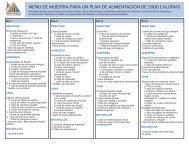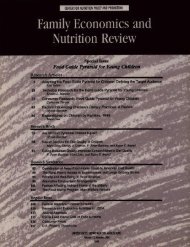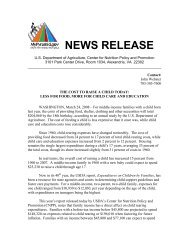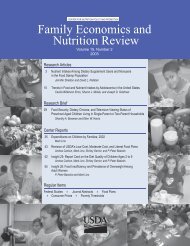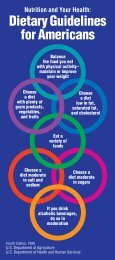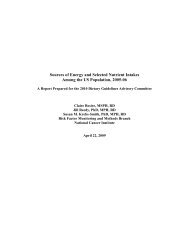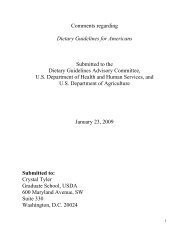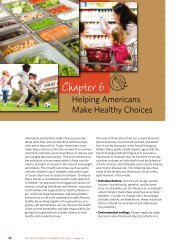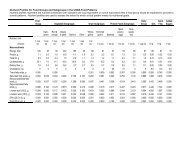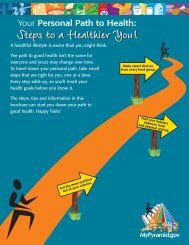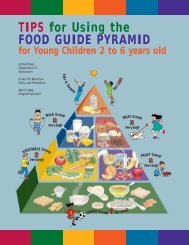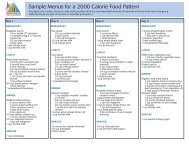Elderly Nutrition - Center for Nutrition Policy and Promotion - US ...
Elderly Nutrition - Center for Nutrition Policy and Promotion - US ...
Elderly Nutrition - Center for Nutrition Policy and Promotion - US ...
Create successful ePaper yourself
Turn your PDF publications into a flip-book with our unique Google optimized e-Paper software.
Baseline<br />
At baseline, heel BMD, weight, <strong>and</strong><br />
height were assessed, <strong>and</strong> participants<br />
answered nutrition <strong>and</strong> health questions<br />
(in no particular order). Heel BMD was<br />
determined with an ultrasound bone<br />
densitometer. 1 A T-score 2 was derived<br />
by comparing each participant’s BMD<br />
with the optimal <strong>and</strong> peak BMD of<br />
a 30-year-old healthy adult. Each<br />
participant received a copy <strong>and</strong> an<br />
explanation of his or her BMD results<br />
(low risk, moderate risk, or high risk<br />
<strong>for</strong> osteoporosis) <strong>and</strong> was strongly<br />
encouraged to take the results to his or<br />
her healthcare provider. Because heel<br />
BMD takes 2 to 3 years to demonstrate<br />
improvement by using the ultrasound<br />
bone densitometer, it was assessed at<br />
baseline only <strong>and</strong> thus not used as an<br />
outcome measure.<br />
Health Education Curriculum<br />
The health education curriculum,<br />
developed <strong>and</strong> modified by five<br />
nutrition <strong>and</strong> pharmacy experts at the<br />
University of Georgia, consisted of<br />
three lessons. The first lesson covered<br />
the definition of osteoporosis, key<br />
nonmodifiable <strong>and</strong> modifiable risk<br />
factors <strong>for</strong> osteoporosis <strong>and</strong> bone<br />
fractures (including tobacco use), <strong>and</strong><br />
balance exercises. The second lesson<br />
covered sources of calcium <strong>and</strong> vitamin<br />
D, including foods that are naturally<br />
rich in calcium, low-lactose dairy<br />
foods <strong>and</strong> use of the lactase enzyme,<br />
calcium-<strong>for</strong>tified foods, <strong>and</strong> calcium<br />
<strong>and</strong> vitamin D supplements. To<br />
encourage a possible new food source<br />
of calcium, those presenting the lessons<br />
gave participants the opportunity to<br />
taste calcium-<strong>for</strong>tified orange juice.<br />
The third lesson reviewed ways to<br />
reduce falls, as well as medications<br />
that may be beneficial <strong>for</strong> bone health.<br />
1 Hologic Sahara Clinical Bone Sonometer,<br />
Bed<strong>for</strong>d, MA, 2000.<br />
2 T-score expresses the number of st<strong>and</strong>ard<br />
deviations from the mean score <strong>for</strong> the<br />
young adult population (Hologic, 2000).<br />
All participants per<strong>for</strong>med balance<br />
exercises from the NIH Osteoporosis<br />
<strong>and</strong> Related Bone Diseases National<br />
Resource <strong>Center</strong> at each lesson. 3<br />
The four messages of this educational<br />
intervention were emphasized in each<br />
lesson: (1) Talk to Your Doctor:<br />
tobacco <strong>and</strong> smoking cessation,<br />
medications, <strong>and</strong> heel BMD results;<br />
(2) Increase Sources of Calcium <strong>and</strong><br />
Vitamin D: dietary sources, <strong>for</strong>tified<br />
foods, <strong>and</strong> dietary supplements;<br />
(3) Take Action: increase physical<br />
activity; <strong>and</strong> (4) Take Care: fallprevention<br />
measures.<br />
Post-Intervention<br />
We administered a post-test about<br />
1 month after completion of the<br />
third lesson to assess participants’<br />
behavioral changes. The questionnaire<br />
contained items that were based on<br />
past nutrition questionnaires developed<br />
<strong>for</strong> this population (Brackett, 1999;<br />
Johnson et al., 2003), as well as<br />
issues related to nonmodifiable <strong>and</strong><br />
modifiable risk factors <strong>for</strong> osteoporosis<br />
<strong>and</strong> bone fractures (NIH, 2001). The<br />
questionnaire included items that<br />
were used to calculate a score <strong>for</strong> the<br />
modifiable osteoporosis-related risk<br />
factors score:<br />
(1) Low intake of calcium-rich<br />
foods⎯consuming less than<br />
3 servings of eight calcium-rich<br />
foods 4 /day.<br />
3 The lesson plans are available on the<br />
<strong>Nutrition</strong> <strong>for</strong> Older Adults’ Health Website:<br />
www.arches.uga.edu/~noahnet. The free,<br />
downloadable lesson plans consist of text <strong>and</strong><br />
script <strong>for</strong> the lessons, h<strong>and</strong>outs, materials <strong>for</strong><br />
overhead transparencies, pre- <strong>and</strong> post-tests, as<br />
well as references <strong>for</strong> additional reading about<br />
nutrition <strong>and</strong> bone health.<br />
4 The eight calcium-rich foods consisted of<br />
milk as a beverage; milk with cereal; yogurt;<br />
cheese; mustard, turnip, or collard greens;<br />
canned salmon; calcium-<strong>for</strong>tified orange<br />
juice; <strong>and</strong> calcium-<strong>for</strong>tified cereals.<br />
(2) Nonuse of calcium supplements⎯<br />
not taking a supplement with<br />
calcium. For the purposes of this<br />
study, a multivitamin supplement<br />
was not considered a calcium<br />
supplement.<br />
(3) Nonuse of vitamin D-containing<br />
supplements⎯not taking any<br />
supplement containing vitamin D.<br />
(4) Low physical activity⎯exercising<br />
less than 5 times/week <strong>and</strong> less<br />
than 150 minutes/week, regardless<br />
of intensity or type of exercise.<br />
(5) High risk of falling at home⎯at<br />
least one of the following risks:<br />
not anchoring throw rugs, not<br />
having grab bars in bathroom, not<br />
having nonskid tape or nonskid<br />
mat in tub or shower area, or not<br />
turning on the light or using a<br />
night-light when getting out of<br />
bed at night.<br />
(6) Current tobacco use.<br />
Other items assessed were medication<br />
history, family history of osteoporosis<br />
<strong>and</strong> bone fractures, medical conditions,<br />
medications, illnesses, osteoporosisrelated<br />
knowledge questions, menstruation<br />
history, <strong>and</strong> results from an<br />
orientation-memory-concentration<br />
(i.e., cognition) test. A panel of nutrition<br />
<strong>and</strong> pharmacy experts reviewed the<br />
questionnaire to increase face validity;<br />
modifications were made based on their<br />
recommendations. To help determine<br />
the reliability of the questionnaire <strong>for</strong><br />
this population, we administered it<br />
twice to the same participants both<br />
be<strong>for</strong>e <strong>and</strong> after the intervention.<br />
Participants were given a test to<br />
determine whether cognition was<br />
related to scores <strong>for</strong> modifiable<br />
osteoporosis-related risk factors.<br />
The cognition measure is a validated<br />
6-item tool that discriminates cognitive<br />
function as being normal or minimally<br />
impaired (score of 8 or less), moderately<br />
impaired (9 to 19), or severely<br />
impaired (20 or more) (Katzman et al.,<br />
2003 Vol. 15 No. 1 85



